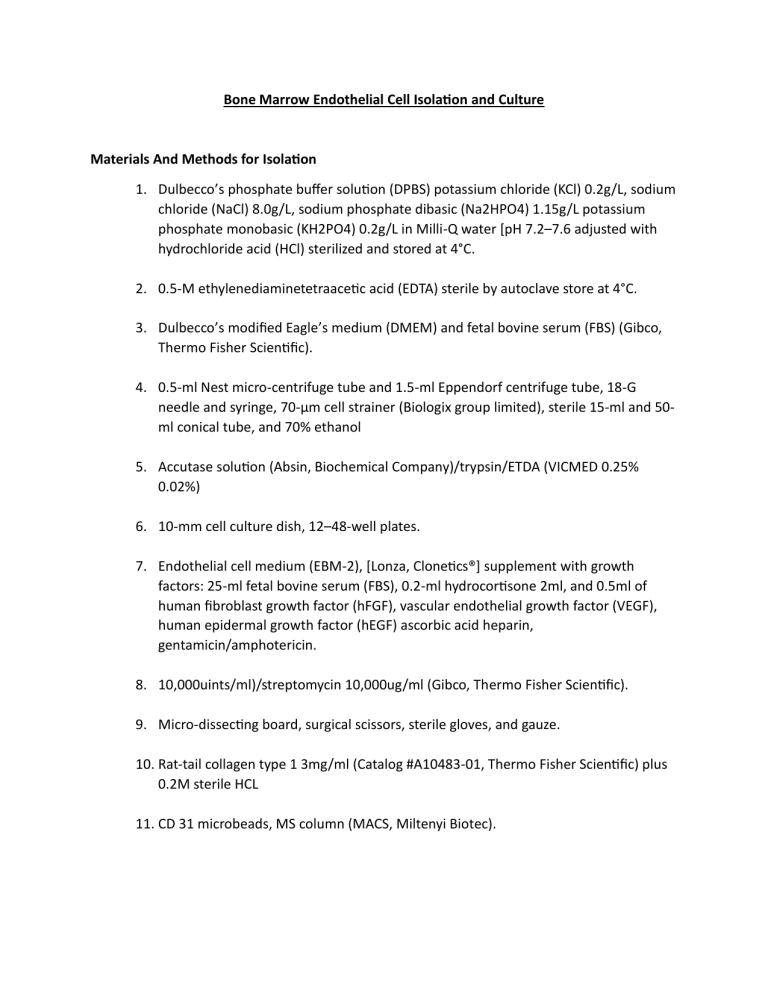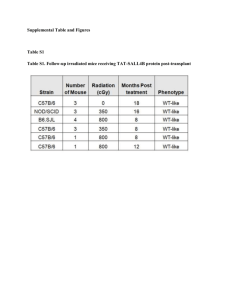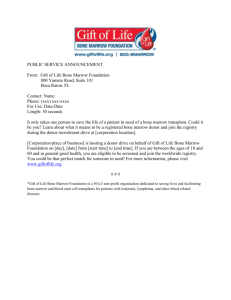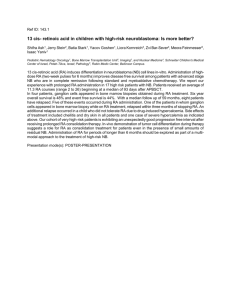
Bone Marrow Endothelial Cell Isolation and Culture Materials And Methods for Isolation 1. Dulbecco’s phosphate buffer solution (DPBS) potassium chloride (KCl) 0.2g/L, sodium chloride (NaCl) 8.0g/L, sodium phosphate dibasic (Na2HPO4) 1.15g/L potassium phosphate monobasic (KH2PO4) 0.2g/L in Milli-Q water [pH 7.2–7.6 adjusted with hydrochloride acid (HCl) sterilized and stored at 4°C. 2. 0.5-M ethylenediaminetetraacetic acid (EDTA) sterile by autoclave store at 4°C. 3. Dulbecco’s modified Eagle’s medium (DMEM) and fetal bovine serum (FBS) (Gibco, Thermo Fisher Scientific). 4. 0.5-ml Nest micro-centrifuge tube and 1.5-ml Eppendorf centrifuge tube, 18-G needle and syringe, 70-μm cell strainer (Biologix group limited), sterile 15-ml and 50ml conical tube, and 70% ethanol 5. Accutase solution (Absin, Biochemical Company)/trypsin/ETDA (VICMED 0.25% 0.02%) 6. 10-mm cell culture dish, 12–48-well plates. 7. Endothelial cell medium (EBM-2), [Lonza, Clonetics®] supplement with growth factors: 25-ml fetal bovine serum (FBS), 0.2-ml hydrocortisone 2ml, and 0.5ml of human fibroblast growth factor (hFGF), vascular endothelial growth factor (VEGF), human epidermal growth factor (hEGF) ascorbic acid heparin, gentamicin/amphotericin. 8. 10,000uints/ml)/streptomycin 10,000ug/ml (Gibco, Thermo Fisher Scientific). 9. Micro-dissecting board, surgical scissors, sterile gloves, and gauze. 10. Rat-tail collagen type 1 3mg/ml (Catalog #A10483-01, Thermo Fisher Scientific) plus 0.2M sterile HCL 11. CD 31 microbeads, MS column (MACS, Miltenyi Biotec). Equipment Needed For isolation (Can be adjusted depending on availability) 1. Laminar flow hook (Thermo Fisher Scientific) 2. High- and low-speed centrifuge (BECKMAN COULTER, Microfuge®20R, and serial no. MRZ14H028, made in Germany, and AIRTECH-KDC-40 Anhui, serial number 02241700049) 3. Nikon Eclipse microscopy (Nikon Eclipse Ti microscopy, Tokyo, Japan) 4. Confocal microscopy (Airyscan, Germany, serial number 182412128) 5. Corning® Matrigel® Basement membrane matrix, Phenol Red-free. *LDEV-free 6. Flow cytometry (BD LSRFortessa™) 7. 5% CO2 humidified incubator (HERA CELL 150i, CO2 incubator, Thermo Fisher Scientific, SERIAL NO. 41629032, Made in Germany) 8. Autoclave machine (HIRAYAMA, HICLAVE™ HVE-50, serial number 30613065826, Made in Japan) 9. Roche real-time quantitative machine (Photonic A-1160, CH-6343)and LightCylcer® 480 Software release 1.5.1.62 SP2) 10. Bio-Rad agarose electrophoresis machine(PowerPac™ Basic serial number 041BR142780, made in Singapore) 11. Magnetic separation column ((MACS, Miltenyi Biotec) 12. NANODROP 2000c Spectrophotometer (Thermo Fisher Scientific) 13. Polymerase chain reaction machine (Mastercycler Nexus gradient, Eppendorf serial number 6331ER910944, Made in Germany) Pre-Requisite Solutions: 1. 1-mm ethylenediamine tetraacetic acid (EDTA)/DBPS (100ul of 0.5M EDTA in 50ml DPBS) 2. Dulbecco’s modified Eagle’s medium (DMEM) plus 20% fetal bovine serum (FBS), and 500ul of penicillin (10,000uints/ml)/streptomycin 10,000ug/ml 3. 50μg/cm2 rat tail collagen type 1 in 0.02M HCl, pre-coat the cell culture dish (12–48 well plates) overnight in the incubator at 37°C 4. Prepare an appropriate volume of the endothelial cells medium supplement with growth factors (minimum 50ml) store at 4°C for 1 month 5. Harvesting buffer solution (2% FBS/1mm EDTA/DBPS) store at 4°C for 1 month Animal Mice Model used in this experiment was similar to the ones found in our lab. C57BL/6 mice. Day 1 The step-by-step process of bone marrow extraction 1. Mice were aged 8–12 weeks (number of mice per experiment (N) = 6) terminated by cervical dislocation. The whole mice were soaked in 70% ethanol for 2–5 min, then placed on the sterile dissecting board on the laminar flow hook. The long bones of the 12 femora and 12 tibias were pulled off with micro-dissecting scissors placed in sterile Dulbecco’s phosphate buffer solution (DPBS) 2. The muscles were detached from the bones by forceps, and the bones scrubbed to remove any residual soft tissues. The bones were washed twice with DPBS solution containing 1mmEDTA. One edge of the long bones cut and placed in a new 10-mm dish containing the DPBS/EDTA solution. 3. An 18-G needle was pushed to the bottom of the 0.5-ml Nest microcentrifuge tube. The long bones’ edge was cut and inverted downwards in the 0.5-ml Nest micro-centrifuge (maximum of 2 tibias and 2 femora) and the lid closed. 4. The 0.5-ml Nest micro-centrifuge tube was transferred into 1.5-ml Eppendorf tubes sealed with Parafilm and centrifuge at 15,000g for 30 s. The 0.5-ml Nest microcentrifuge was discarded and the visible pellet at the bottom of the 1.5 ml Eppendorf tubes suspended with sterile DPBS/EDTA solution. 5. The suspended bone marrow cells with the PBS/EDTA solution, filtered with a 70-μm cell strainer (Biologix group limited) and centrifuge at 300g for 5 min at room temperature. The pellet resuspended in DMEM supplemented with 20% fetal bovine serum (FBS), and 500μl of penicillin (10,000 units/ml)/streptomycin 10,000ug/ml. 6. The cells were plated in a sterile 10-mm dish with a minimum of 109 cells/plate and incubated in a 5% CO2 humidified incubator overnight. Day 2 The step-by-step process of isolating bone marrow endothelial cells 1. After overnight incubation, the floating cells poured off. The cultured marrow-adherent cells were washed with sterile DPBS twice and detached with appropriate accutase solution for 15 min at room temperature. 2. The detached cells were suspended with the harvesting buffer [PBS, 2% FBS, 1-mm ethylenediaminetetraacetic acid (EDTA), and penicillin/streptomycin)] with repeated pipetting to detached the remaining cells. The cells were transferred into 15-ml tubes, centrifuge at 300g for 10 min at room temperature—the total cell number determined by a hemocytometer or automated cell counting machine. 3. The pellet cells were resuspended with the harvesting buffer solution with CD31 microbeads by manufacturer’s protocols and kept at 4°C for 15 min. 4. The cells were resuspended with 10 ml of harvesting buffer solution, then centrifuge at 300g for 10 min at room temperature to wash off the cells’ excess beads after 15 min incubation. 5. The MS column attached to the magnetic washed once with the harvesting buffer, bone marrow cells pass through the column. The magnetic cells were washed three times with the harvesting buffer, followed by a single wash with endothelial cell medium supplement with growth factors. 6. The magnetic cells are pushed into new sterile tubes with the endothelial cell medium supplement with growth factors; the total number of cells count is determined by a hemocytometer or automated cell-counting machine. 7. The plate pre-coated with rat-tail collagen type 1, washed with sterile DPBS solution twice, and followed by one wash with the endothelial cell medium supplement with growth factors. Appropriate cells number (200–300 cells/ml) seeded into the coated dishes (12–48-well plates) and incubated into the incubator. Characterization of Mice Bone Marrow Endothelial Cells There are several different methods in which we can characterize mice bone marrow endothelial cells. 1) The first method relies on using confocal microscope bone marrow endothelial cells are capillary like structures. 2) The next method relies on using flowcytometry Flow cytometry analysis of bone marrow endothelial cells The selected CD31 microbead-positive cells analyzed by flow cytometry with a panel of antibodies: [CD31 (PE. anti-mouse, eBioscience™), CD45 (FITC anti-mouse, eBioscience™) CD106 (PE, Rat-anti-mouse, BD-Pharmingen™), CD144 (APC, anti-mouse, eBioscience™), and endothelial selective adhesion molecule (ESAM) (APC, anti-mouse, Biolegend®) antibodies]. 500,000 cells/ml were collected per tube, washed with PBS, centrifuged at 400g for 5 min at room temperature (×2), incubated with the recommended dilution of antibodies, stored at 4°C for 1 h, and analyzed by flow cytometry (BD LSRFortessa™) within 24 h. The lower threshold uses to exclude debris and the live cells with gating (20,000 cells) according to forward scatter (FSC) × side scatter (SSC), followed by sections containing the antibodies. The data retrieve from the flow cytometry software and analyze by FlowJo software version 7.6.2. 3) The Third method relies on using immunofluorescence to characterize bone marrow endothelial cells The characterization of bone marrow endothelial cells by immunofluorescence staining To certify the bone marrow endothelial cells for the expression of CD31 (PECAM-1), VE-cadherin (CD144) and ICAM-1 with passage zero were determined by direct immunofluorescence staining. The CD31 microbead-positive cells (50 000 cells) were plated into pre-coated 48-well with rat tail collagen type 1 for 5–7 days, as described above. After 60–70% of the confluence, the medium removed, cells fixed with 4% paraformaldehyde (PF) for 20 min at RT, followed by two wash 3 min apart with PBS. The cells were permeabilized with 100% cold methanol at room temperature for 20 min, rinsed with PBS three times, and blocked with 1% BSA/PBS for 1 h at room temperature. Cells incubated with the recommended dilution of primary antibodies overnight at 4°C. The cells were cleaned twice with PBS and counterstained with Hoechst for 5 min at 37°C. The cells were washed with PBS and imaging acquired using inverted Nikon microscopy (Nikon Eclipse Ti microscopy, Tokyo, Japan). Primary and secondary antibodies are shown in (Table 3) with a dilution of 1:100 for primary antibodies and 1:500 for secondary antibodies in 1%BSA/PBS solution. To Culture Bone Marrow Mouse Endothelial Cells, the following is required: primary bone marrow endothelial cell proliferation To examine the cell proliferation of primary bone marrow endothelial cells, 105cells were seed in 48-well plates incubated for 7 days. After 7 days, the BMECs were stimulating with recombinant TNF-α (10 ng/ml) and the control with 1% FBS with DPBS for 48 h. The medium containing the recombinant cytokine and FBS/DPBS was replaced with a new endothelial cell medium supplement with growth factors and incubated for another 7 days. The cells were harvested by trypsin/ETDA (VICMED 0.25% 0.02%), centrifuged at 350g for 5 min, wash 2x with PBS, and fixed with 70% cold–ethanol kept at −20°C for 1 h. The fixed cells were centrifuged as above followed by washed with FACS buffer incubated with Ki-67 (FITC, anti-mouse, BioLegend®) and F4/80 (APC, anti-mouse as isotype control BioLegend®) for 30 min at room temperature. The data was acquired by flow cytometry. The cells were stained with trypan blue for the cell count, and live cells were counted by hemocytometer.





